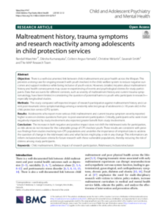Displaying 881 - 890 of 2214
This article follows on from ‘How children in foster care engage with loyalty conflict: presenting a model of processes informing loyalty’ (Dansey, John and Shbero, 2018), published in the previous edition of this journal.
This study uses a qualitative approach to explore the experiences of 22 UK foster carers when a child is ‘moved on’ from a placement, focusing specifically on their experiences of loss.
As agencies consider how to build the capacity of carers to support unaccompanied young people, this study set out to learn from the experiences and views of foster carers, in order to inform the development of effective carer training and support.
The importance of mental and behavioral health for child welfare clients is well-documented; yet, little is known about the challenges therapeutic service providers (TSPs) experience working in child welfare practice. To explore this topic, five focus groups were conducted with 40 TSPs in a contracted mental and behavioral health agency and data were analyzed following an inductive thematic process.
The objective of this study was to identify factors associated with difficult parenting experiences and placement disruption.
This paper draws on an evaluation of the effectiveness of the Nurturing Attachments groupwork programme provided by AdoptionPlus for adoptive families in England. The Nurturing Attachments programme, informed by Dyadic Developmental Psychotherapy (Hughes, Golding & Hudson, 2015), was developed to help foster and adoptive parents strengthen their relationships with the child and support children who had experienced developmental traumas.
This study has three aims: (1) to provide an overview of a module designed to support relationship building between LGBTQ+ youth in foster care and their caregivers, (2) to describe the theater testing procedure used to assess usability of the developed module with foster caregivers and adults, and (3) to share the results of the theater test.
This article explores the history of strained relations between the Norwegian Child Welfare Services (CWS) and various migrant groups.
This open access study compared self-reported impact of research participation against maltreatment history and current post-traumatic stress symptomatology among a randomly selected group of adolescents (< 18 years old) in the child protection service (CPS) system.
The present study aimed to measure lifetime prevalence and frequency rates of child physical and emotional abuse, neglect, domestic violence, and several types of sexual and peer victimization among adolescents in residential care.

